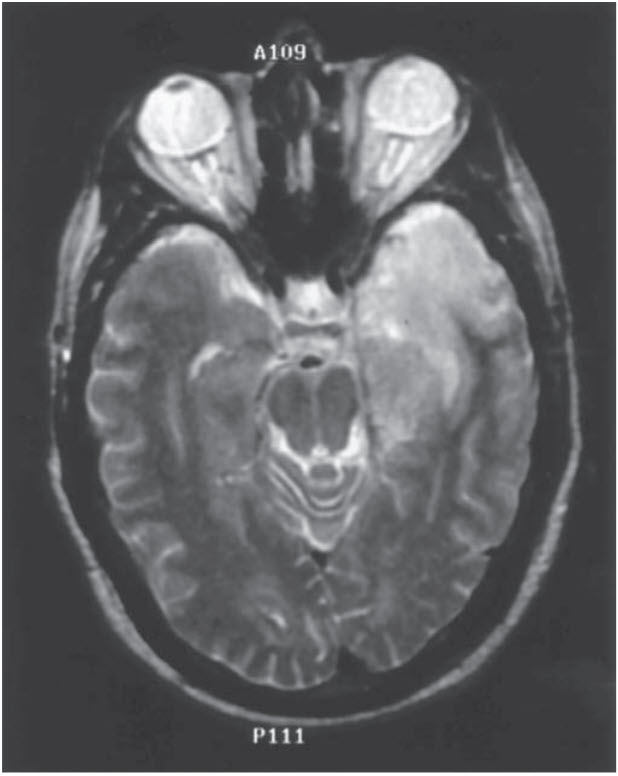Question 7#
A 32-year-old man is brought into the Emergency Department after he had a seizure. He has no history of a seizure disorder and there was no preceding trauma, new medications, or illicit drugs. On examination, his temperature is 38.9°C, blood pressure is 118/70 mmHg, heart rate is 90 beats per minute, and respiratory rate is 12 breaths per minute. He is lethargic and has a horizontal gaze palsy affecting the left eye. Appropriate laboratory values are sent, and a lumbar puncture and MRI (Figure below) are performed. The CSF studies show a large number of RBCs in each tube.

Which of the following therapies is most likely to be active against this condition?
A. DexamethasoneB. Vancomycin
C. Amphotericin B
D. Acyclovir
E. Ceftriaxone
Correct Answer is D
Comment:
Acyclovir. The only medication on the list that has activity against herpes simplex virus type 1 (HSV-1) is acyclovir. HSV is the most common cause of sporadic encephalitis and has a very high morbidity and mortality. It presents acutely with fever, mental status changes, and focal neurologic deficits; affected patients may also have symptoms of meningitis. Whereas meningitis is caused by inflammation of the meninges surrounding the brain (infection of the subarachnoid space), encephalitis is caused by inflammation of the brain parenchyma. There is frequently overlap of the two conditions (meningoencephalitis).
Other findings in the above vignette that suggest this diagnosis are elevated RBCs in the CSF in each tube (as opposed to a traumatic spinal tap, in which the concentration of RBCs would diminish with each tube), and inflammation of the left temporal lobe seen on MRI. HSV should be highly suspected in any patient with encephalitis, and the above findings are virtually diagnostic of HSV; however, the diagnosis can be confirmed with PCR or viral culture of the CSF. If suspected, empiric acyclovir should be started immediately. One potential adverse reaction of acyclovir is acute renal failure, which can occur secondary to crystal formation in the tubules.
(A) Dexamethasone is a strong corticosteroid that can be used in cases of S. pneumoniae meningitis, which is not the likely diagnosis based on the MRI showing encephalitis. (B, E) Ceftriaxone and vancomycin are used for empiric antibiotic treatment of meningitis. Ceftriaxone is effective against S. pneumoniae, N. meningitidis, and H. influenzae, and vancomycin is effective against cephalosporin-resistant S. pneumoniae and S. aureus. (C) Amphotericin B is used for cryptococcal meningitis, which is the most common manifestation of Cryptococcus neoformans in HIV patients.